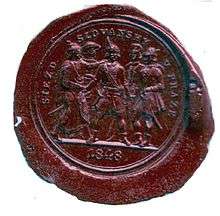Prague Slavic Congress, 1848
The Prague Slavic Congress of 1848 (also known as the Pan-Slav Congress of 1848) took place in Prague between June 2 and June 12, 1848. It was first occasion on which voices from all Slav populations of Europe were heard in one place.[1] The meeting was meant to be a show of resistance to German and Hungarian nationalism in the city of Prague in the predominantly Slavic Kingdom of Bohemia.
Several other Slavic Congresses were held in different eastern European cities over the next century.
Background
Pan-Slavism
Pan-Slavism developed over time leading up to the Congress in 1848. The development of some sort of national identity helped unite Slavic lands against increasing German nationalism. The identification of these lands as Slavic did not detract from the cultural variation known to have developed over centuries among the Slavic nations (e.g. West Slavic Czechs, South Slavic Bulgarians and East Slavic Russians).
The Congress


The exact goal of the Congress was unclear even as it was beginning. In addition to lacking a goal, the conference planners also quarreled over the format and the agenda of the gathering.[2] Perhaps this was an indication of how difficult the conference would be for the factions to come together.
Once underway, the conference met in three sections: Poles and Ukrainians; South Slavs; and Czecho-Slovaks. The Pole-Ukrainian section contained a combination of Ruthenes, Mazurians, Greater Poles, and Lithuanians.[3] Of the total 340 delegates at the Congress, the greatest number came from the Czecho-Slovak section. 237 Czecho-Slovaks participated along with 42 South Slavs and 61 Pole-Ukrainian.[4] German was the primary language used during discussions.
During the Congress, there was debate about the role of Austria in the lives of the Slavs. Dr. Josef Frič argued that the “primary goal is the preservation of Austria”, adding that the Congress “only differs on the means.”[5] This point was disputed by Ľudovít Štúr who told the Congress, “our goal is self-preservation”.[6] Such a disconnect was typical of the environment of this conference.
One important statement did come out of the conference around June 10, when the Manifesto to the Nations of Europe was pronounced. The statement was a strongly worded proclamation that demanded an end to the oppression of the Slav people.[7] The Slavs did not look for any type of revenge,[8] but they wanted to “extend a brotherly hand to all neighbouring nations who are prepared to recognize and effectively champion with us the full equality of all nations, irrespective of their political power or size”.[9] This was an important development because it indicated some sort of unity among all of the Slav people of Europe.[10]
The Congress was cut short on June 12, when fighting broke out on the streets.[11] This later became known as the Whitsuntide events because of the timing during the Christian holiday of Pentecost. The delegates left in disgust and some were even arrested because of the revolutionary nature of the Congress.[12]
Notable participants
- Czech-Slovak group
- František Palacký, Czech historian, oversaw the entire conference as president.
- Pavel Jozef Šafárik, from Hungary, chairman of the Czecho-Slovaks.
- Ľudovít Štúr,
- František Zach,
- Polish-Ukrainian group
- Karol Libelt, Prussian, chairman of the Poles and Ukrainians.
- Iwan Borysykewycz,
- Hryhorij Hynyłewycz,
- Ołeksa Zakłynśkyj,
- Mikhail Bakunin, Russian radical
- South Slavic group
- Stanko Vraz, Slovene-Croatian poet, vice-president of congress.
- Pavo Stamatović, Serbian, chairman of the South Slavs.
- Jovan Subotić, Serbian poet, lawyer and politician.
Notes
- ↑ Magocsi, Paul R.; Pop, Ivan Ivanovich (2002). Encyclopedia of Rusyn History and Culture. University of Toronto Press. p. 373. ISBN 9780802035660. Retrieved 4 June 2012.
- ↑ (Orton 57)
- ↑ (Orton 62)
- ↑ (Orton 63)
- ↑ (Orton 69)
- ↑ (Orton 69)
- ↑ (Orton 87)
- ↑ (Orton 88)
- ↑ (Orton 88)
- ↑ (Polišenský 147)
- ↑ (Orton 86)
- ↑ (Orton 86)
References
- Michael J. Flack (1953). The Slav-Congresses and Pan-Slavism, 1848-1914. Fletcher School of Law and Diplomacy.
- Lawrence D. Orton (1978). The Prague Slav Congress of 1848. East European Quarterly. ISBN 978-0-914710-39-4.
- Horst Haselsteiner (2000). The Prague Slav Congress 1848: Slavic Identities. East European Monographs. ISBN 978-0-88033-450-1.
- Polišenský, Josef: Aristocrats and the Crowd in the Revolutionary Year 1848. Albany: State University of New York Press, 1980.